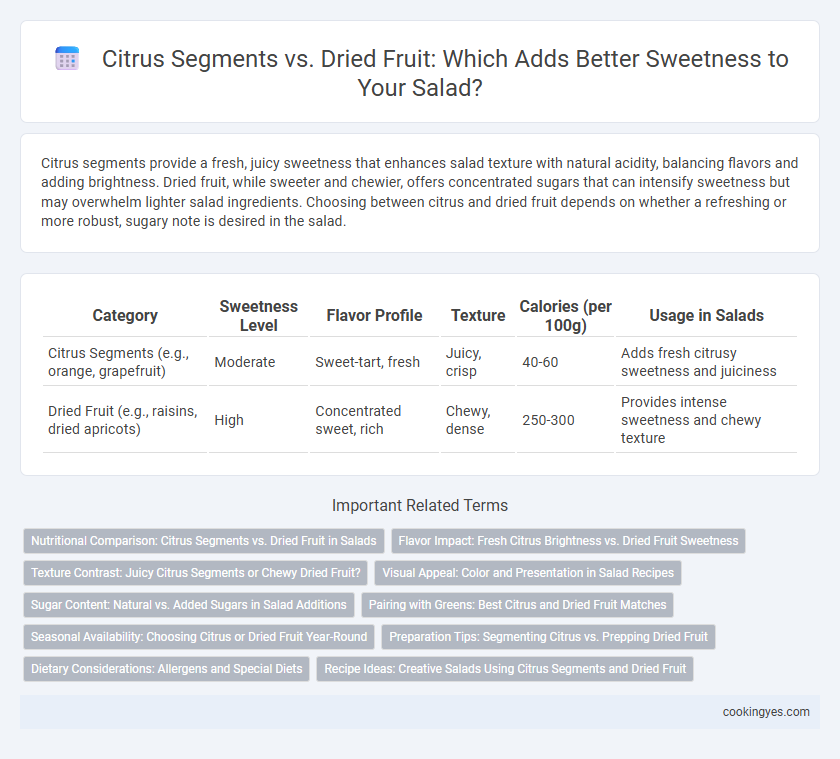Citrus segments provide a fresh, juicy sweetness that enhances salad texture with natural acidity, balancing flavors and adding brightness. Dried fruit, while sweeter and chewier, offers concentrated sugars that can intensify sweetness but may overwhelm lighter salad ingredients. Choosing between citrus and dried fruit depends on whether a refreshing or more robust, sugary note is desired in the salad.
Table of Comparison
| Category | Sweetness Level | Flavor Profile | Texture | Calories (per 100g) | Usage in Salads |
|---|---|---|---|---|---|
| Citrus Segments (e.g., orange, grapefruit) | Moderate | Sweet-tart, fresh | Juicy, crisp | 40-60 | Adds fresh citrusy sweetness and juiciness |
| Dried Fruit (e.g., raisins, dried apricots) | High | Concentrated sweet, rich | Chewy, dense | 250-300 | Provides intense sweetness and chewy texture |
Nutritional Comparison: Citrus Segments vs. Dried Fruit in Salads
Citrus segments provide hydration and are rich in vitamin C and antioxidants, offering a low-calorie, nutrient-dense option for sweetness in salads. Dried fruits, while higher in natural sugars and calories, supply concentrated fiber, iron, and potassium but may increase overall sugar content significantly. Choosing citrus segments enhances freshness and vitamin intake, whereas dried fruits add texture and nutrient density with a higher glycemic impact.
Flavor Impact: Fresh Citrus Brightness vs. Dried Fruit Sweetness
Fresh citrus segments provide a vibrant, tangy brightness that enhances salad flavors with a zesty, refreshing acidity. Dried fruit, such as cranberries or apricots, delivers concentrated sweetness and chewy texture, adding depth and richness to the dish. Combining both elements balances the tartness and sweetness, creating a complex flavor profile that elevates any leafy green or grain-based salad.
Texture Contrast: Juicy Citrus Segments or Chewy Dried Fruit?
Juicy citrus segments offer a refreshing burst of moisture that contrasts sharply with crisp greens, enhancing the salad's overall texture. Chewy dried fruits like apricots or raisins provide a denser, more concentrated sweetness, creating a satisfying contrast against crunchy elements. Balancing these textures elevates the salad's complexity, appealing to both tactile and flavor senses.
Visual Appeal: Color and Presentation in Salad Recipes
Citrus segments add vibrant hues of orange, yellow, and ruby red that enhance the visual appeal and create a fresh, colorful contrast in salad recipes. Dried fruit, such as raisins or cranberries, provides deeper, richer tones like dark red and brown that contribute a warm, rustic look but may lack the brightness of fresh citrus. Combining both ingredients can balance vivid color diversity and texture, elevating the overall salad presentation.
Sugar Content: Natural vs. Added Sugars in Salad Additions
Citrus segments provide natural sugars primarily in the form of fructose and glucose, contributing a fresh, balanced sweetness while also adding vitamins like vitamin C and fiber. Dried fruits contain concentrated natural sugars, often higher in total sugar content per serving due to water removal, which can raise the glycemic load of salads. Unlike added sugars, natural sugars from fresh and dried fruits enhance flavor and nutrient density, making them healthier options for sweetening salads without processed sugar additives.
Pairing with Greens: Best Citrus and Dried Fruit Matches
Citrus segments like oranges, grapefruits, and mandarins provide a refreshing, juicy sweetness that pairs exceptionally well with peppery greens such as arugula and watercress, balancing bitterness with bright acidity. Dried fruits like cranberries, apricots, and raisins offer concentrated sweetness and chewy texture, complementing earthy spinach and kale by adding depth and contrast. Combining both citrus segments and dried fruits in a salad enhances flavor complexity while maintaining harmony with various leafy greens.
Seasonal Availability: Choosing Citrus or Dried Fruit Year-Round
Citrus segments provide bright, juicy sweetness primarily in winter and early spring when they are in peak season, enriching salads with fresh, vibrant flavors. Dried fruits like raisins, apricots, and cranberries offer concentrated sweetness and are available year-round, making them a reliable choice for salad sweetness during off-season months. Combining seasonal citrus with dried fruits allows for optimal flavor balance in salads regardless of the time of year.
Preparation Tips: Segmenting Citrus vs. Prepping Dried Fruit
Segmenting citrus for salad requires careful removal of the peel and membrane to expose bright, juicy segments that add fresh, tangy sweetness and vibrant texture. Preparing dried fruit involves selecting soft varieties like apricots or cranberries, chopping them into bite-sized pieces to evenly distribute concentrated sweetness without overpowering other ingredients. Both techniques enhance the salad's flavor balance, with citrus segments contributing refreshing bursts and dried fruit providing chewy, natural sugar notes.
Dietary Considerations: Allergens and Special Diets
Citrus segments provide natural sweetness to salads while being low in calories and free from common allergens like nuts and gluten, making them ideal for individuals with dietary restrictions such as gluten intolerance or nut allergies. Dried fruits, although rich in fiber and nutrients, often contain added sugars and sulfites that may trigger sensitivities or allergic reactions in some people. Opting for fresh citrus over dried fruit supports clean eating principles and better aligns with special diets including paleo, keto, and Whole30.
Recipe Ideas: Creative Salads Using Citrus Segments and Dried Fruit
Citrus segments bring vibrant acidity and juiciness to salads, enhancing flavors with natural sweetness and a refreshing zing. Dried fruit offers concentrated sweetness and chewy texture, adding depth and contrast to leafy greens or grain bases. Combining both ingredients in creative salads delivers a balanced taste profile, perfect for recipes like citrus-avocado salad with dried cranberries or mixed greens topped with orange segments and apricot pieces.
Citrus segments vs dried fruit for salad sweetness Infographic

 cookingyes.com
cookingyes.com